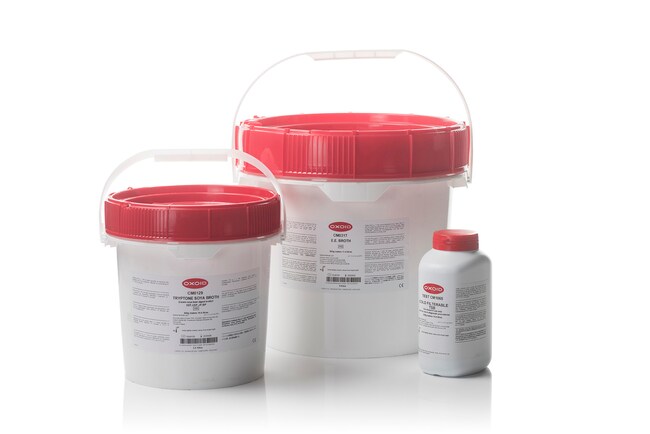Search Thermo Fisher Scientific
- Contact Us
- Quick Order
-
Don't have an account ? Create Account
Search Thermo Fisher Scientific

Isolate and enumerate Staphylococcus aureus with selective and sensitive Thermo Scientific™ Oxoid™ Baird-Parker Agar Base (Dehydrated).
Baird Parker Agar Base contains carefully balanced selective inhibitory agents, glycine, lithium, and tellurite, to suppress the growth of most of the bacteria present in foods without inhibiting coagulase-positive staphylococci. The presence of egg yolk emulsion and sodium pyruvate aid the recovery of damaged cells for presumptive identification of Staphylococcus aureus in food specimens.
| Certifications/Compliance | Industrial Reference: AFNOR, AOAC, BSI, EP, IDF, ISO, NMKL, USDA. |
| Description | Baird-Parker Agar Base |
| Form | Powder |
| Product Type | Agar |
| Quantity | 500 g |
| Yield | For 7.9L medium |
| Unit Size | Each |
| Catalog Number | Specifications | Unit Size | Quantity | Price (JPY) | |||||||||||||||||||||||||||||||||||||||||||||||||||||||||||||||||||||||||||||||||||||||||||||||||||||||||||||
|---|---|---|---|---|---|---|---|---|---|---|---|---|---|---|---|---|---|---|---|---|---|---|---|---|---|---|---|---|---|---|---|---|---|---|---|---|---|---|---|---|---|---|---|---|---|---|---|---|---|---|---|---|---|---|---|---|---|---|---|---|---|---|---|---|---|---|---|---|---|---|---|---|---|---|---|---|---|---|---|---|---|---|---|---|---|---|---|---|---|---|---|---|---|---|---|---|---|---|---|---|---|---|---|---|---|---|---|---|---|---|---|---|---|
| CM0275B | Each | 500 g | Request A Quote | ||||||||||||||||||||||||||||||||||||||||||||||||||||||||||||||||||||||||||||||||||||||||||||||||||||||||||||||
| |||||||||||||||||||||||||||||||||||||||||||||||||||||||||||||||||||||||||||||||||||||||||||||||||||||||||||||||||
Baird-Parker Agar Base is widely recommended by national and international bodies for the isolation of Staphylococcus aureus1.
Baird-Parker2 developed this medium from the tellurite-glycine formulation of Zebovitz et al.3 and improved its reliability in isolating Staphylococcus aureus from foods. Baird-Parker added sodium pyruvate, to protect damaged cells and aid their recovery3
Egg yolk emulsion makes the medium yellow and opaque. Staphylococcus aureus reduces tellurite to form grey-black shiny colonies and then produces clear zones around the colonies by proteolytic action. This clear zone with typical grey-black colony is diagnostic for Staphylococcus aureus. On further incubation, most strains of Staphylococcus aureus form opaque haloes around the colonies.
Some strains of Staphylococcus saprophyticus may also produce both clear zones and opaque haloes but can be distinguished by the longer incubation required4.
Colonies typical of Staphylococcus aureus, but without an egg yolk reaction, should also be tested for coagulase production5. Egg yolk reaction negative Staphylococcus aureus may occur in some food, especially cheese.
Not all products are available for sale in all territories. Please inquire.
Remel™ and Oxoid™ products are now part of the Thermo Scientific brand.
1. Chopin A., Malcolm S., Jarvis G., Asperger H., Beckers H. J., Bertona A. M., Cominazzini C., Carini S., Lodi R., Hahn G., Heeschen W., Jans J. A., Jervis D., I., Lanier J. M., O’Connor F., Rea M., Rossi J., Seligmann R., Tesone S., Waes G., Mocquot G. and Pivnick H. (1985) ICMSF Methods studies XV. J. Food Protect. 48. 21-27.
2. Baird-Parker A. C. (1962) J. Appl. Bact. 25. 12-19.
3. Zebovitz E., Evans J. B. and Niven C. F. (1955) J. Bact. 70. 686-689.
4. Baird-Parker A. C. (1963) J. Gen. Microbiol. 30. 409-413.
5. Chopin A., Malcolm S., Jarvis G., Asperger H., Beckers H. J., Bertona A. M., Cominazzini C., Carini S., Lodi R., Hahn G., Heeschen W., Jans J. A., Jervis D., I., Lanier J. M., O’Connor F., Rea M., Rossi J., Seligmann R., Tesone S., Waes G., Mocquot G. and Pivnick H. (1985) ICMSF Methods studies XV. J. Food Protect. 48. 21-27.